Angie BrownEdinburgh and East reporter
 BBC
BBCA former railway line which runs through Edinburgh is at the centre of a heated debate over whether it should return as a tram line.
The railway closed about 60 years ago but in the 1980s it was resurfaced and named The Roseburn Path as a temporary corridor for cyclists and pedestrians.
It has become one of the most used off-road cycle paths in Edinburgh, with about 600,000 trips made by foot, bike and wheelchair along the route every year.
However, city planners now want to reclaim the path for a second tram line between Granton in the north and the Royal Infirmary in the south east.
An alternative option via Orchard Brae and across the A-listed Dean Bridge is also being considered.
A 12-week public consultation on the project ends on 17 November.
Where is Roseburn Path and what are the council’s plans?
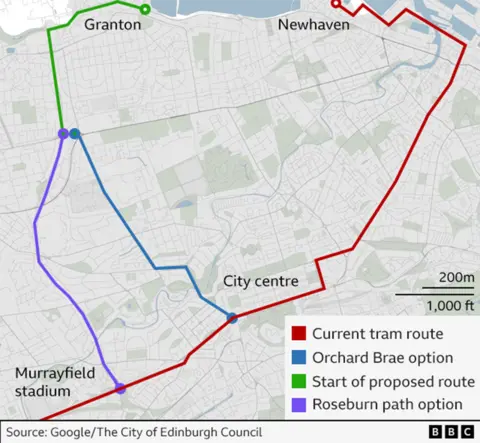
Council officials recommended The Roseburn Path as the “preferred route” for the tram line early last year.
But councillors were inundated with protests over the loss of the cycle path and decided the plans should go out to public consultation.
Since then, the plans have been revised so that trams can share the 2 mile (3.1km) section of route with pedestrians, cyclists and wheelchair-users.
The proposals would see two tram lines along part of the route, dropping to one line along a mile of the narrowest section of the path.
A signalling system would allow trams on the single line section to travel in both directions.
A 1.5m (5ft) high fence and a buffer zone of between 0.5m (1.6ft) and 1.9m (6.2ft) would keep the trams apart from other path users.
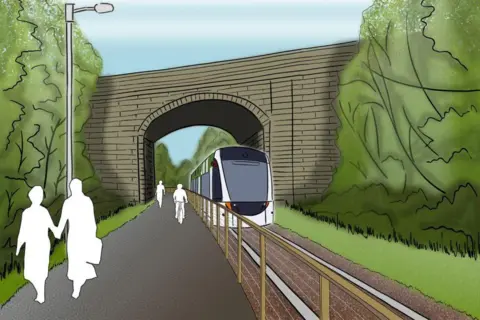 City of Edinburgh Council
City of Edinburgh CouncilCouncil officials have calculated that 93% of the path would have a minimum of 3m (10ft) of space for walking, wheeling and cycling and some places would have up to 4.2m (13.8ft).
A pinch point at Telford Road Bridge would see the path narrow to 2.17m (7.1ft), while at Roseburn Terrace Bridge it would be down to 2m (6.5ft).
There would also be alternative routes via Wester Coates and Balburnie Place for those requiring more space.
What are campaigners’ objections to the Roseburn Path plans?
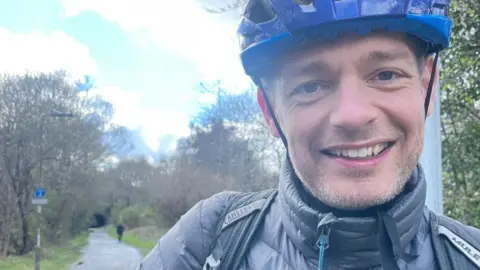
Campaign groups say the proposed path would be too narrow to share with trams and they have raised concerns about the impact on trees and wildlife.
The plans show 70% of the trees would be retained along the path with reports saying 25% of the vegetation “needing scaling back due to it being dead, diseased or invasive species”.
Battery-operated trams would mitigate the loss of some of the canopy of trees as there would be no need for overhead lines, according to the proposals.
The trams, which would be retrofitted from existing stock, would charge at each tram stop as passengers got on and off.
But Euan Baxter, of Save The Roseburn Path, said the Edinburgh council was proposing the “destruction of a park”.
“That doesn’t fit with national policy objectives on access to green space, protection of biodiversity and the promotion of active travel,” he said.
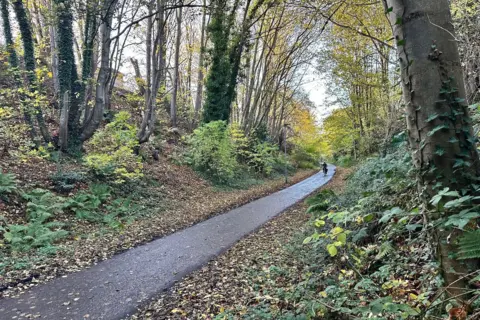
He said sharing the path with trams was dangerous.
“There are dangerous crossings and narrowings where cyclists would be forced to cycle beside trams going at 40mph, which is quite different to cycling along an off-road quiet route,” he said.
“We believe trams should go on the road and take away space from cars, not what is a local park taking space away from people.”
The Roseburn Path is also part of National Cycle Route 1 and connects on to the north Edinburgh path network, with onward links to Fife, Leith and the Union Canal link to Glasgow.
Research by the Walk Wheel Cycle Trust (formerly Sustrans) found that about 600,000 trips were made on the path every year.
What are the benefits of using Roseburn Path for trams?
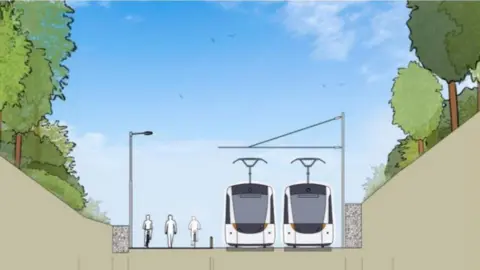 City of Edinburgh Council
City of Edinburgh CouncilCity planners says the benefits include:
- Faster and more reliable journey times because trams would not have to compete with other road vehicles
- Quicker construction time than the alternative Dean Bridge route, as the off-road path avoids major road closures and moving underground utility pipes
- Better passenger numbers, with forecasts suggesting there could be 4.25 million passengers by 2042 – 500,000 fewer passengers than the alternative
- It would be the cheaper option, with the whole line from Granton to the Royal Infirmary costing about £2bn compared to about £2.9bn if it goes along the Orchard Brae/Dean Bridge route

Lawrence Marshall, Capital Rail Action Group chairman, said The Roseburn Path was the “only viable option”.
“For decades, it’s been envisaged trams would one day run along the old railway track bed from Roseburn to Granton,” he said.
“Indeed, parliamentary consent was granted for this back in 2006 and was an expensive process.”
He added: “The council has now proposed that, in order to keep an active travel route alongside, the tram route from Roseburn to Craigleith should be only single rather than double track – and powered by batteries rather than overhead wire to keep tree loss to a minimum.
“That brings with it operational risk for the trams – but it’s an honest attempt to address the concerns of those who have grown to value the current active travel and leisure use of the former railway track bed.
“For Edinburgh to grow sustainably, it’s a compromise they should accept.”
What is the alternative to using the Roseburn Path for the tram extension?
 Guven Ozdeemir/Getty Images
Guven Ozdeemir/Getty ImagesAny proposed tram line will have to cross the Water of Leith – a 13-mile river that cuts across Edinburgh.
The alternative to the Roseburn Path proposal would see the tram line going across Dean Bridge.
Council reports say the cost of the modifying the bridge to be able to take the weight of the trams would make this option significantly more expensive than the Roseburn Path.
However, campaigners say this would be preferential as the Dean Bridge is already used by vehicles.
Trams could go up to twice the speed on the Roseburn Path – reaching 40mph – making it eight minutes quicker than the Dean Bridge option.
However, this is one of the biggest complaints from campaigners who say this would make several exit points along the path dangerous to cross and would also ruin the ambiance of the leafy and tranquil corridor.
What is the council’s response to the plans?
Stephen Jenkinson, City of Edinburgh Council’s transport and environment convener, said the capital was facing major challenges in terms of population growth.
“We will not stand by and do nothing as some seem to be suggesting,” he said.
“The tram is a potentially transformational development for our whole city, and we owe it to future generations to be bold and ambitious.”
He said the council remained committed to maintaining the city’s 144 parks.
“Edinburgh is the UK’s greenest city, with almost half of the city being classed as green space and more trees per person than any other city in the UK,” he added.
Disclaimer : This story is auto aggregated by a computer programme and has not been created or edited by DOWNTHENEWS. Publisher: BBC








